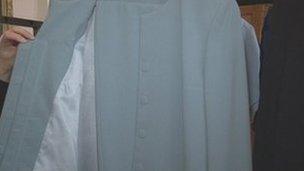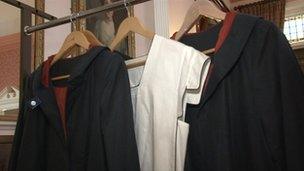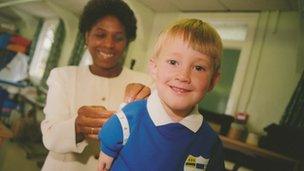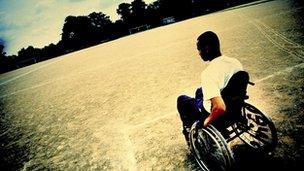Fashion label caters for disabled women
- Published
Fashion designer Ann Oliver: "One hates to be a lump in a wheelchair"
For most of us, getting dressed is a straightforward part of our morning routine. However, for wheelchair users and people with limited mobility it can be a real challenge.
Doing up zips and buttons can be a frustrating struggle - and how do you find trousers that slip on easily when you find it difficult to stand?
"It's something that you wouldn't think about until you're in that situation," says Ann Oliver.
Mrs Oliver was diagnosed with multiple sclerosis in 1990, the year her sister died of the same disease.
Her condition has progressed to the extent that she now uses a wheelchair to get around.
Over the years she has noticed that it is very difficult to find stylish clothes that are easy for her to put on by herself. She says: "I still want to be looking good in an unconventional but fashionable way sitting in my wheelchair."
'Correct length'
Mrs Oliver enrolled on a course at Central St Martins College in London, with the aim of creating a clothing line for disabled and "unconventional" women.

Magnetic fastenings snap the jacket shut, so getting dressed is easier for people who struggle with buttons
Her first collection, Xeni, was launched online earlier this year. She has designed coats and jackets that use magnets as self-propelled fastenings.
The coats are also cut out at the back, meaning the wearer can sit down without the collar pulling uncomfortably at the neck.
There are trousers which provide extra length at the back of the waist to make sure they are the correct length for women who are sitting in wheelchairs.
She has also designed evening dresses which accentuate the shoulders, and draw attention away from the lap.
Start-up business
Mrs Oliver set up the business using money she had saved with her husband.
She says the economic climate did not put her off starting up the business "for one second".
It may not have fazed her, but it may well prevent some of her potential customers from buying the clothes.

Ann Oliver: "My garments are made by experienced tailors who all have also to pay London prices"
They are manufactured on a small scale in north London rather than the Far East, meaning the clothes are expensive.
Furthermore, half a million people are expected to lose their Disability Living Allowance over the next four years, meaning many will struggle to afford to pay the £130 she charges for a pair of trousers.
But Mrs Oliver says she has had a lot of interest from potential customers already and with 10 million disabled people in the UK, hers is a niche but sizeable market.
And while High Street stores like Debenhams have had well-publicised advertising campaigns using disabled models, there are very few shops that provide clothes suitable for disabled men and women.
'Can't look in the mirror'
A quick Google search for clothes for disabled people brings up practical but, in the main, unstylish clothes.
Of course, there is a wide range of disabilities and different needs. But for some people, the lack of choice can have a huge impact on their self-esteem.
Nicola Carrig is an occupational therapist at Stoke Mandeville Hospital's Spinal Injuries Unit. Many of her patients are young adults coming to terms with life-changing injuries.
"A lot of patients struggle psychologically and can't even look at themselves in the mirror," she says.
"They need to feel better about themselves as they move into the next stage of rehabilitation - and clothing can help with that."
Tailor-made
In the 1980s there were eight charities in the UK that made or altered clothes for people with disabilities. There is roughly half that number now.
One of them is Clothing Solutions, a small charity that has been running in Bradford for the last 30 years.
There, anyone can bring in a garment from a High Street store, and the tailors will adapt it to suit the wearer. For many young adults, it is a way they can wear their favourite brands - but with a bit of extra help in the form of Velcro or loops.

Clothing Solutions tailor school jumpers for George Buxey
Sandra Hunt is the manager of Clothing Solutions and she says there is nothing they cannot do.
"For example, schoolchildren with muscular dystrophy may struggle to wear blazers, because of the chairs. So we cut their blazers in half and join them with a strap at the back," she says.
However, Clothing Solutions relies on fundraising and is struggling to survive.
"It costs £65,000 a year to run, and we keep dipping in and out of the red."
This is partly because they charge their customers so little. A pair of specially adapted trousers will cost the client about £50, but cost a lot more to make.
Ms Hunt is calling for more government funding, so they can mass-produce some clothes and keep their prices down. "It would be ideal if everyone had access to this service," she says.
Not on the High Street
This call for inclusion is echoed by Christine Shaw, chief executive of the charity, the Disabled Living Foundation.

Many young people with disabilities want to be able to shop for clothes on the High Street
She says there are not enough fashionable clothes for people with restricted movement, or who use wheelchairs.
"Designers, manufacturers and retailers have gone some way to respond to this customer need and demand," she says. "It's time they did so in an area that could make a difference, potentially, to millions of men and women in the UK."
So why don't High Street shops stock clothes that would suit people whose mobility is restricted?
Retail analysts say it is mainly because the High Street deals in volume, and manufacturing specialist clothes simply wouldn't be worth their time.
Luckily for Ann Oliver and her new collection, this space in the market is something she may be able to capitalise on.
- Published24 March 2012
- Published28 January 2012